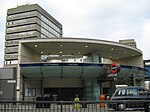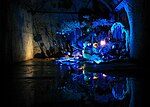The Cut, London
History of the London Borough of LambethLondon road stubsRestaurant districts and streets in EnglandStreets in the London Borough of LambethStreets in the London Borough of Southwark ... and 1 more
Use British English from June 2015

The Cut (formerly New Cut) is a street in London which runs between Waterloo Road in Lambeth and Blackfriars Road in Southwark, approximately parallel to the South Eastern Railway (England). The Old Vic theatre is at the western (Lambeth) end, and the more experimental Young Vic theatre halfway along on the other side. Lewisham Southwark College is sited on the south side of The Cut and at the eastern (Southwark) end is Southwark Underground station. Waterloo and Waterloo East stations are also nearby.
Excerpt from the Wikipedia article The Cut, London (License: CC BY-SA 3.0, Authors, Images).The Cut, London
The Cut, London Southwark (London Borough of Southwark)
Geographical coordinates (GPS) Address Nearby Places Show on map
Geographical coordinates (GPS)
| Latitude | Longitude |
|---|---|
| N 51.503416666667 ° | E -0.10683333333333 ° |
Address
Premier
The Cut
SE1 8LP London, Southwark (London Borough of Southwark)
England, United Kingdom
Open on Google Maps









